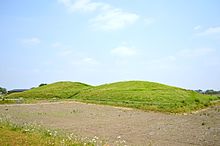Hododa Kofu group

Hododa-Kofun group ( Japanese 保 渡 田 古墳 群 Hododa kofungun ) is an archaeological site from the late Kofun period with three keyhole-shaped barrows ( 前方 後 円 墳zempō kōenfun ) in the Japanese community of Takasaki , Gunma prefecture . The site was declared a National Historic Site in 1985. The burial mounds are in all probability the graves of an influential noble family.
overview
The excavation site is located at the southern foot of the Haruna Mountain and is spread over the area of the districts of Hododa and Ide. It includes the three great barrows ( Kofun ) Futagoyama ( 二 子 山 古墳 ), Hachimanzuka ( 八 幡 塚 古墳 ) and Yakushizuka ( 薬 師 塚 古墳 ). The barrows date from the second half of the 5th and the beginning of the 6th century.
The Futagoyama Kofun (located in the southwest of 36 ° 22 '42.8 " N , 138 ° 59' 0.9" O ) m with a length of 108 m in diameter 74 and a height of ten meters for the round part and with a diameter of 71 m and a height of seven meters for the rectangular part, the largest of the three kofun. The burial mound has a three-tier structure. The barrow is surrounded by two horseshoe-shaped trenches. There are four small islets between the inner ditch around the round part of the Kofun and the outer ditch (see aerial photo). The concave part and the islets have a stone cover ( 葺 石fukiishi ). In this part, cylindrical haniwa were found . In the area from the northern corner of the inner trench to the northwest corner of the outer trench, anthropomorphic haniwa ( 人物 埴 輪jinbutsu haniwa ), horse jewelry , plus device haniwa with a shield shape ( 盾形 埴 輪tategata haniwa ), animal shape, parasol haniwa ( 蓋 形埴 輪kinugasagata haniwa ) and house haniwa ( 家 形 埴 輪iegata haniwa ).
At the top of the round part in the middle there is a shaft built with stones from a dry river bed, which leads to a stone chamber. In the stone chamber there was a boat-shaped stone coffin. Broken and damaged artefacts such as helmets, spears, farm implements and harnesses were found here as a result of illegal excavations . In addition, the capstone of the stone coffin could not be found.
The Hachimanzuka Kofun ( 36 ° 22 ′ 51.9 ″ N , 138 ° 59 ′ 8.7 ″ E ) is 102 m long; the round part of the keyhole-shaped burial mound has a diameter of 56 m and a height of six meters. The rectangular part is flat and 53 m wide. This barrow is also bordered by two narrow, horseshoe-shaped ditches that enclose four small islets. This Kofun also has a stone paving. Here, too, anthropomorphic haniwa and haniwa in animal form (horses, pigs and water birds) were excavated. The discovery of a haniwa in the form of a cormorant with a fish in its beak and a small bell with a cord around its neck attracted attention. Such a form of cormorant fishing is known from ancient Chinese and Japanese sources such as the Sui Shu , the Kojiki and the Nihonshoki .
The excavation area of the third burial mound, the Yakushizuka Kofun ( 36 ° 22 ′ 57.8 ″ N , 138 ° 58 ′ 58.9 ″ E ), is bordered and cut off on the south and east side by temples and the cemetery of the Saikō temple . This barrow is approx. 105 m long and six meters high. It is believed that this barrow was also surrounded by an inner and an outer moat. It is also a three-tier kofun with stone paving.
The Kofu group is located in the historical park "Kamitsukenu Haniwano-sato" ( 上 毛 野 は に わ の 里 公園 ) with a size of 190,000 m², of which 63,000 m² were considered in the declaration of national cultural property.
As early as September 1939, an ensemble of artifacts excavated in Hododa was declared an important cultural asset . This ensemble includes a bronze mirror, three comma-shaped beads made of agate and two made of lapis lazuli , nine rod and 360 round beads made of jade , horse bits, seven three-leaved peach leaves made of bronze, three sword points, floral fittings and bronze bells.
literature
- Ishizuka Masahide: 保 渡 田 古墳 群 見 学 (= 頸 城 野 郷 土 資料室 学術 研究 部 研究 紀要 ). May 24, 2017, ISSN 2432-1087 , p. 1-3 .
Web links
- 保 渡 田 薬 師 塚 古墳 (高崎 市) . (PDF)Retrieved November 10, 2019(Japanese).
Individual evidence
- ↑ 保 渡 田 古墳 群 . In: 国 指定 文化 財 等 デ ー タ ベ ー ス . Cultural Affairs Office , accessed November 10, 2019 (Japanese).
- ↑ Werner Steinhaus: Small dictionary on Japanese archeology . epubli, Berlin 2010, ISBN 978-3-86931-803-5 , p. 115 .
- ↑ 保 渡 田 八 幡 塚 古墳 . 古墳 マ ッ プ , 2019, accessed November 10, 2019 .
- ↑ 保 渡 田 古墳 群 . Takasagi City, accessed November 10, 2019 .
- ↑ 保 渡 田 古墳 群 . Gunma Tougoku Bunka Navi, 2019, accessed November 10, 2019 (Japanese).


